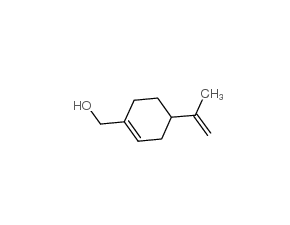
Perillyl alcohol
CAS No. 536-59-4
Perillyl alcohol( —— )
Catalog No. M18757 CAS No. 536-59-4
Perillyl Alcohol is a naturally occurring monoterpene related to limonene with antineoplastic activity.
Purity : >98% (HPLC)
 COA
COA
 Datasheet
Datasheet
 HNMR
HNMR
 HPLC
HPLC
 MSDS
MSDS
 Handing Instructions
Handing Instructions
| Size | Price / USD | Stock | Quantity |
| 100MG | 38 | In Stock |


|
| 200MG | Get Quote | In Stock |


|
| 500MG | Get Quote | In Stock |


|
| 1G | Get Quote | In Stock |


|
Biological Information
-
Product NamePerillyl alcohol
-
NoteResearch use only, not for human use.
-
Brief DescriptionPerillyl Alcohol is a naturally occurring monoterpene related to limonene with antineoplastic activity.
-
DescriptionPerillyl Alcohol is a naturally occurring monoterpene related to limonene with antineoplastic activity. Perillyl alcohol inhibits farnesyl transferase and geranylgeranyl transferase, thereby preventing post-translational protein farnesylation and isoprenylation and activation of oncoproteins such as p21-ras, and arresting tumor cells in the G1 phase of the cell cycle.
-
In Vitro——
-
In Vivo——
-
Synonyms——
-
PathwayOthers
-
TargetOther Targets
-
RecptorOthers
-
Research AreaOthers-Field
-
Indication——
Chemical Information
-
CAS Number536-59-4
-
Formula Weight152.23
-
Molecular FormulaC10H16O
-
Purity>98% (HPLC)
-
SolubilityIn Vitro:?DMSO : 100 mg/mL (656.90 mM)
-
SMILESCC(=C)C1CCC(=CC1)CO
-
Chemical Name——
Shipping & Storage Information
-
Storage(-20℃)
-
ShippingWith Ice Pack
-
Stability≥ 2 years
Reference
1. Ripple GH.?Clin Y Res?2000;6:390-6.
molnova catalog



related products
-
Pinocembrin 7-O-[3''...
Pinocembrin-7-o-3-o-galloyl-4-6-hexahydroxydiphenoyl-beta-d-glucoside can moderately inhibit α-amylase activity, with the IC50 value of 0.03 umol/ml.
-
N-Formyl-Met-Leu-Phe...
N-Formyl-Met-Leu-Phe-Lys (fMLFK) is a peptide, acts as a potent and selective agonist of FPR1, with EC50s of 3.5 nM, 6.7 μM and 0.88 μM for FPR1, FPR2 and FPR2-D2817.32G, respectively.
-
IELLQAR (8 - branch ...
IELLQAR (8 - branch MAPS) Selectin Binding Peptide



 Cart
Cart
 sales@molnova.com
sales@molnova.com


